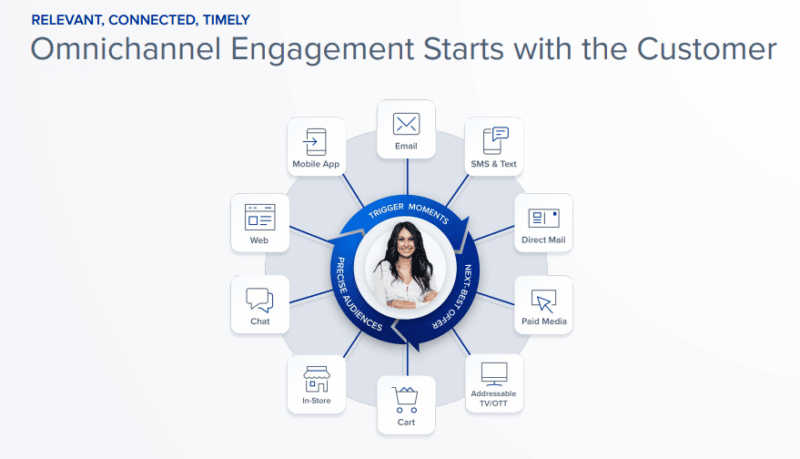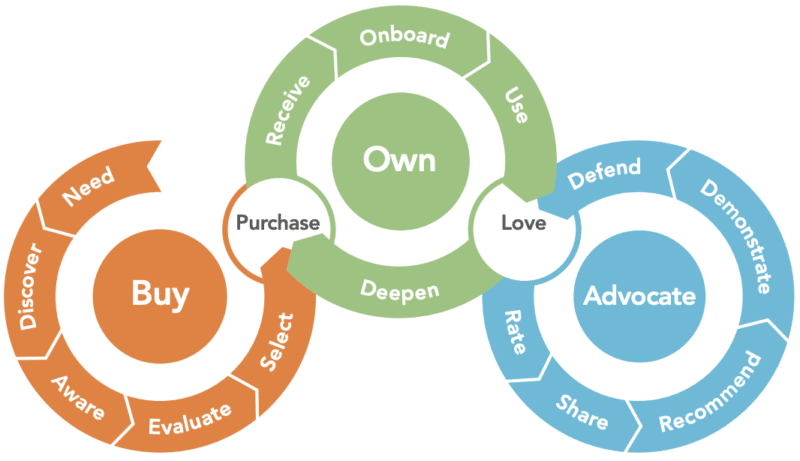Marketing your services is essential for building your brand image and reputation. One of the best ways to do so is by prioritizing customer experience (CX).
Customer experience focuses on the relationship between a business and its customers. It includes every form of interaction or communication with the customer, whether direct or indirect, even if it doesn’t result in a purchase. When optimizing for customer experience, marketers emphasize tasks that increase engagement at every touchpoint.
In this article, we’ll dive deep into why and how businesses should have a more customer-centric approach and answer the most frequently asked questions about customer experience. More specifically, we’ll cover:
Estimated reading time: 15 minutes
Why is customer experience important?
A positive customer experience can massively boost your business. It can help retain clients and encourage them to refer your company to others. After all, word of mouth marketing is one of the most influential elements driving purchase decisions today. In fact, 84% of customers say they trust online reviews as much as personal recommendations, according to BrightLocal’s Local Consumer Review Survey.
Marketers are recognizing the benefits of CX platforms and strategies in growing numbers, especially after the onset of the COVID-19 pandemic. 94% of marketers changed their digital CX strategy over the 18 months following the pandemic onset, according to Acquia’s Global CX Report. And data from Pointillist suggests that digital transformation of tools and strategies remains one of the top CX priorities for brands.
Customer experience can make or break your brand, so marketers would be wise to invest in solutions that drive positive interactions.
Examples of positive customer experience
Essentially, customers are more likely to return to your business if they feel like their needs are understood and expectations are met. This includes listening to customer feedback and implementing changes.
Some other examples of positive customer experience include:
- Intuitive website design.
- Realistic expectations about products or services.
- Sales being transparent about pricing.
- Easy-to-access self-help resources.
- Always-available live customer support with a short waiting time.
- Proactive messaging around known issues.
- Use customer feedback to understand your audience thoroughly.
- Smooth omni-channel experiences (ex. website and mobile app integration)
Good customer experience encompasses more than the absence of disjointed elements. It requires brands to proactively engage with customers in creative ways to foster greater engagement.
Examples of bad customer experience
Poor customer experience, on the other hand, may cause serious damage to your brand’s reputation and negatively impact brand loyalty. The implications of bad customer experience are far-reaching and may involve customers switching to a competitor, poor lead conversion, and a drop in your customer lifetime value.
To put it simply, a bad customer experience is when a customer feels a business has failed to meet their expectations. The most common indicators of poor customer experience in digital interactions include:
- Having to enter information multiple times.
- Unresolved issues/questions.
- Too much automation.
- Service that is not personalized.
- Websites that are slow to load.
- Confusing UI/UX.
Poor customer experience has the potential to derail your B2B marketing campaigns. Because so much time and effort is put into purchasing decisions, these potential buyers are more aware of disruptions and discrepancies that make their jobs even more difficult. Brands that force customers to take undesirable actions or sift through disjointed experiences will inevitably see more drop-offs.
Get the daily newsletter digital marketers rely on.
How to choose the right customer experience strategies
While many customer perceptions of your brand hinge on personal preferences, there are plenty of tactics marketers can enact to foster better experiences. These strategies are designed to measure, facilitate, and foster more positive customer experiences at every touchpoint.
Here are some tips on how you can improve your customer experience strategy.
Create feedback loops
Customer feedback is the easiest way to understand what your customers expect from you and understand how to provide them with a better experience. It provides first-hand insight into what customers think about your brand, what issues they have, and what works for them.
Remember to acknowledge their feedback and do your best to act on it. This builds trust, shows your customers that you care, and gives them a solid reason to continue doing business with you.
Create an omnichannel experience
When you develop an omnichannel CX strategy, you’re creating a more efficient and effective way for customer service agents to interact with customers. Having multiple channels that integrate within a single system allows customers to pick up right where they left off, providing a consistent communication journey and delivering a good experience across channels.

Personalize the user experience
Personalization includes interactions through customers’ preferred method of contact, product recommendations based on past purchases and search history, or an online experience tailored to each customer.
Using data to figure out who your customer is (their preferences, habits, basic personality, etc.) helps marketers better understand what customers expect, which can lead to faster support and resolutions.
Empower customers through AI
Digitalization is evolving at an increasingly rapid rate, and through it, so are machine learning applications, chatbots, or mobile messaging. AI-powered chatbots and virtual customer assistants are effective for quick, repetitive tasks.
Keep In touch with your customers
Ensuring your customers remember you is essential to retaining them. Following up with customers through their preferred contact method or surveys can help you learn where to improve your business and show your customers they matter. Adding them to a mailing list can also be a way to send them personalized recommendations, letting them know when you expand your services or offer them seasonal or customized discounts. It helps you build trust and familiarity with your customers.
Deliver proactive experiences
In addition to acknowledging and responding to customer reviews and feedback, businesses can be proactive in their approach. Anticipating customers’ needs and solving problems before they arise or escalate can help generate unique and personalized experiences.
Create a FAQ page
Customers often prefer resolving issues on their own rather than contacting a live service agent if the issue is fairly common. You can help them by making self-help services more accessible and easy to use. Usually, this is in the form of a FAQs page that quickly resolves relatively common customer questions. Ensuring that your content is accurate and regularly updated is crucial – an unhelpful article can quickly translate into a poor experience.
Use analytics to improve the customer journey
Research and data provide many insights into the efficiency of your customer support team. Data helps improve customer satisfaction with the interactions, provides insights regarding consumer behavior trends, and much more. Modifying processes and services with your customers in mind begins with understanding what your existing data is telling you.

How to measure customer experience?
Customer expectations are constantly changing, so the services put forth to meet their expectations need to change with time as well. Being able to measure how well your customer experience strategies are working allows you to know what’s helpful and what to improve.
Many marketers map out customer journeys to better understand their experiences. This exercise helps them see the buying experience from the customer perspective, allowing them to more easily pinpoint areas in need of improvement.
Mapping out customer journeys also provides a good framework for measuring the success of marketing campaigns. Whether it’s how engaged customers are with your content or how many purchases are made, marketers can customize these maps to reflect their brand’s KPIs.
Here are some of the most effective ways marketing teams can measure customer experience.
Use data to analyze customer satisfaction
Surveys can give you insight into factors like customer satisfaction scores (CSAT) and Net Promoter Scores (NPS). CSAT surveys measure customers’ satisfaction with the product or service they receive from you. They are usually expressed with a 5- or 10-point scale (where 1 means “very unsatisfied” and 10 means “very satisfied”) or through binary yes/no answers. NPS is a customer loyalty score derived from asking customers, “On a scale from 0 to 10, how likely are you to recommend this product/company to a friend or colleague?” You can, of course, choose to modify the question slightly to suit your brand or business.
CSAT surveys are more specific to the product and service they receive from you, while NPS is more focused on customers’ overall feelings toward your brand.
Customer effort score (CES) measures the experience customers had with a product or service in terms of how “difficult” or “easy” it was for them to complete an action or obtain a resolution. CES surveys are often sent out after an interaction with customer service, with questions such as, “How easy was it to get your issue resolved today?” It is a great way to keep in touch with your customers and gain quick feedback.
Analyze customer churn rate and the reasons behind it
Customer churn is a normal part of business, but it’s vital that you learn from it so that you can prevent it from happening due to poor customer experiences.
Regularly analyzing churned customers can help determine whether your churn rate is increasing or decreasing. It can also help you understand the reasons for churn; for example, if customers responded well to your personalized communications and returned for business, you know that team or area of your company is doing a good job.
Community forum discussions are a great place to understand customer pain points, how customers receive and use your product and what they are asking for. It works like customer feedback, which can provide direct insight into how customers feel about their interactions with your business.
Forums can be shared via email surveys, social media, or a community page and give customers the chance to offer suggestions proactively.
Look at customer service data
Look into how long customers have to wait before reaching live service agents or getting an answer. Long wait times are a major reason for poor customer experience.
Also, look for recurring issues among support tickets and understand why they exist. Resolving these issues before customers bring them to you allows you to decrease the total number of tickets your agents receive while providing a streamlined and enjoyable experience.
Talk to customer-facing staff
In addition to creating feedback loops with customers, marketers should build them with their employees as well. Customer-facing staff, like service agents, may have insights based on direct input from customers or their own experience while dealing with customers. This allows you to understand if and why employees may be having difficulties meeting expectations and what you can do to improve that.
Popular customer experience platforms
Customer experience platforms are designed to help brands manage their interactions with customers to enhance customer satisfaction. They serve as a single place for brands to manage the entire customer lifecycle journey, from overseeing a customer’s interaction to responding to queries.
As customer expectations keep rising, it is crucial for brands to use personalization to improve customer experience. Here are some of the most popular customer experience platforms that can enhance your customer experience.
Zendesk
Zendesk offers many features, such as a ticketing system for quicker customer service, that lets you build an integrated help center and a community forum for consumers who use your products. It is very easy to navigate and has many customizations, giving you a complete view of every customer interaction. It also helps your business stay aligned by enabling a complete sync between all agents with its Sunshine platform.
Sunshine has a unique feature called the “Zendesk Marketplace,” which allows you to connect to 1,200+ apps. A one-stop shop to find partners, apps, and integrations, it increases agent productivity and streamlines workflow.
Adobe Experience Manager (AEM)
The most striking feature of the Adobe Experience Manager is its open architecture, allowing you to easily integrate it with existing enterprise software systems. AEM gives you a powerful enterprise toolkit that includes web analytics, automated tools for personalized content experiences, and smart tools to rapidly source, adapt, and deliver your assets across digital audiences.
It can help customers through every step of the process from acquisition through retention with its digital enrollment and forms feature. The feature also offers end-to-end digital document solutions, which make it easy to create responsive forms that customers can easily complete and securely e-sign.

Explore DAM solutions from vendors like Acquia, Widen, Cloudinary, MediaValet and more in the full MarTech Intelligence Report on digital asset management platforms.
Satmetrix
Satmetrix offers brands holistic customer experience solutions, including omnichannel feedback and a customer journey-based design. Its features enable you to combine and analyze all forms of feedback across the customer journey. And, its VOC solution NICE Satmetrix allows you to optimize customer experiences by giving you unified customer feedback from millions of customer interactions.
Satmetrix is built to enhance efficiency by acting in real-time to empower front-line employee performance and help them resolve issues through automated agent workflows.
Zoho CRM Plus
Zoho CRM Plus helps brands improve customer experiences through its wide range of unified solutions. The platform provides marketers with omnichannel engagement support, social media marketing tools, marketing analytics, chatbots, and customer segmentation features.
The platform’s emphasis on unification can help brands meet customer expectations at every stage of their journey. And, since it’s a CRM, the tool brings all team members onto the same page to prevent disruptions in communications.
Qualtrics
The Qualtrics customer experience platform uses AI and automation to provide marketers with resources to foster greater levels of engagement. Qualtrics can use customer data to generate feedback forms, surveys, and other resources that address your audience’s most pressing needs.
This experience management solution also helps brands make better campaign decisions with recommended actions based on customer trends and patterns.
The number of customer experience platforms available is growing by the day, and for good reason. They’re one of the best ways to help you attract and retain loyal customers. They are driving the future of quality customer experiences for companies worldwide and helping build powerful brands.
Frequently asked questions about customer experience
Marketers and brands know customer experience solutions are necessary to increase engagement and ROI, but many have questions regarding why it’s important, how to deliver results, and how to improve it.
Here are some of the most popular questions marketers ask regarding customer experience.
What is the difference between customer experience and customer service?
Simply put, customer service is just one part of the whole customer experience.
Customer experience is a customer’s overall perception of your company based on their interactions with it. In comparison, customer service refers to the specific interactions within the experience where a customer is seeking assistance or support.
Customer service is generally reactive – it only comes into play when customers contact the company for support or feedback. On the other hand, customer experience is proactive – you can optimize how customers feel about your business before they even reach out or have an issue.
What is great customer service?
A great customer experience is quick and easy, but it also reflects empathy and customers’ values. They crave personalized experiences. In fact, roughly 80% of consumers are more likely to make a purchase when brands provide personalized experiences, according to data from Epsilon.
What can cause a bad customer experience?
In short, a bad customer experience fails to meet customers’ needs. Long wait times and having to repeat information multiple times are two major factors that can cause a poor experience. Research from Qualtrics found that 80% of consumers say they would switch to a competitor following a poor customer experience with a brand.
What is the role of customer experience?
The role of a customer experience team is to ensure your company is meeting customers’ needs and expectations. This includes gathering customer data like feedback and churn rates and sharing them with various teams across the company to solve issues and make sure they aren’t recurring.
What is customer experience management?
Customer experience management involves designing ways to ensure customer interactions meet or exceed their expectations. The aim is to promote greater customer satisfaction, loyalty, and advocacy. This can be done by focusing on marketing, sales, product, and customer service.
However, to successfully manage customer experience and deliver value, businesses should look at the organization as a whole instead of trying to figure out how to improve each part. Looking at the areas individually can be time-consuming and leads to businesses missing out on how these areas affect each other. Taking a more holistic approach while monitoring the customer journey can lead to more satisfaction and loyalty.

Explore capabilities from vendors like Adobe, Pointillist, SharpSpring, Salesforce and more in the full MarTech Intelligence Report on customer journey analytics platforms.
How improved customer experience helps brands
According to the U.S. Census Bureau, more than 5.4 million new business applications were filed in 2021. This is a clear indicator that businesses will have to be unique, experience-driven, and differentiable to succeed. Enabling excellent customer experiences will act as a huge differentiator for your brand, helping with customer acquisition, brand loyalty, and customer retention.
Here are some of the most important benefits of improved customer experience.
Greater profits
Companies that excel at customer experience drive higher revenues and profits than their competition. A better customer experience leads to higher customer retention, a five times cheaper alternative to customer acquisition.
Word of mouth and brand loyalty
Word of mouth marketing is key to organic growth. Excellent customer experience means customers are more than happy to recommend your brand to their inner circle and are open to purchasing your products again.
Enhanced customer experiences help you build a strong connection with your customers. It helps you create a winning experience that helps you stand out from your competition.
Improved company culture and reputation
Building a better customer experience helps you nurture a company culture that is centered around customer satisfaction. This is especially important today in the digital age, where customer feedback can either make or break your brand.
Improving customer experience creates a powerful foundation for your company as one that pays attention to the evolving needs of its customers. It is one of the most undervalued assets of any business and can scale up your growth, sustainability, and reach. It will grow your brand value exponentially.
Provide the best customer experience you can
Think of the last time you had a great experience purchasing a product or service – how did that experience leave you feeling? Now, do the same for a poor experience you’ve had as a customer. What would you have liked that business to do better?
Having a customer-centric approach when coming up with new ways to grow or promote your business can go a long way. Collecting customer feedback and analyzing trends to improve negative experiences and enhance positive ones will help boost customers’ feelings about your company. A happy customer is likely to come back for more – they’re one of the best ways to increase brand awareness. At the end of the day, customer satisfaction should be a key part of your marketing plan.
Source link




